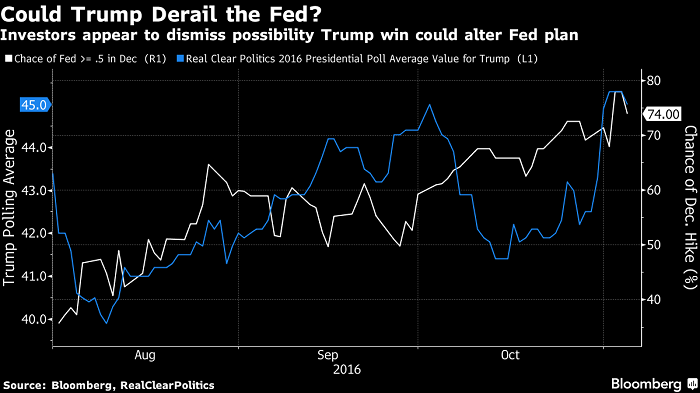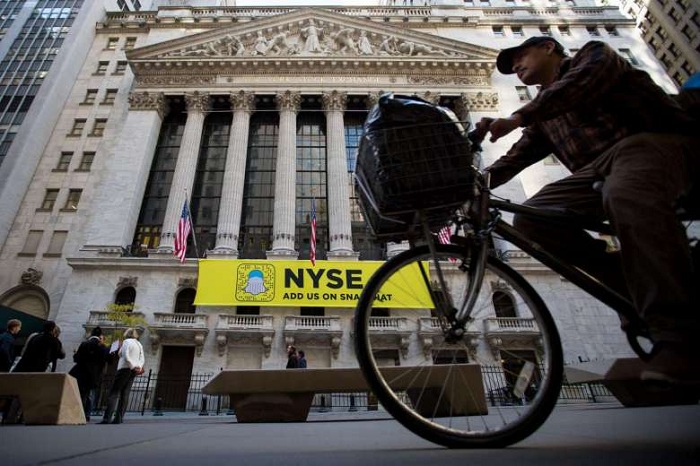This matters because the compulsion to act in the vote’s aftermath is often very strong -- stocks swing twice as violently as normal those days, data compiled by Bloomberg show. They plummeted 5 percent just after Barack Obama beat John McCain in 2008. But while nothing says Wednesday’s reaction won’t be a harbinger for the year, nothing says it will, either, and investors should think before doing anything rash.

“Trying to trade that is very difficult,” said Thomas Melcher, the Philadelphia-based chief investment officer at PNC Asset Management Group. “Even if the market sells off, if you have any reasonable time horizon, that should be a buying opportunity. The dust will settle and people will conclude the economy is OK.”
In the 22 elections going back to 1928, the S&P 500 has fallen 15 times the day after polls close, for an average loss of 1.8 percent. Stocks reversed course and moved higher over the next 12 months in nine of those instances, according to data compiled by Bloomberg.
On Monday, futures on the S&P 500 expiring in December climbed 1.4 percent at 10:20 a.m. in London, after the FBI said Hillary Clinton didn’t commit a crime in her handling of e-mails as secretary of state.
Nothing shows the unreliability of first-day signals more than the routs that accompanied victories by Obama, whose election in the midst of the 2008 financial crisis preceded a two-day plunge in which more than $2 trillion of global share value was erased. It wasn’t much better in 2012, when Election Day was followed by a two-day drop that swelled to 3.6 percent in the S&P 500, at the time the worst drop in a year.
Of course, Obama has been anything but bad for equities -- or at least, he hasn’t gotten in their way. The S&P 500 has posted an average annual gain of 13.3 percent since Nov. 4, 2008, better than nine of the previous 12 administrations. Data like that imply investors struggle to process the meaning of a new president just after Election Day, or infuse the winner with greater influence than they have.
“Some people are probably going to overreact, and there will be other investors trying to second-guess what those investors are doing,” said David Brown, a professor of finance at the University of Wisconsin School of Business, in Madison, Wisconsin. “There is a salience of short-term events, particularly bad events, that lead people to react to short-term information.”
Swings in industries are no more prescient than the broader market. The S&P 500 Health Care Index declined 3.6 percent the day after Obama first won; since then it’s the stock market’s third-best performing group with a 149 percent advance. Also meaningless is the victor’s party. The median S&P 500 gain in Democratic terms since 1928 has been 27.7 percent, according to Leuthold Group LLC, compared with 27.3 percent under Republicans.
“The results suggest that policy differences between the parties are either fully reflected in stock prices by the time a candidate officially takes office, overwhelmed by larger cyclical forces, or fundamentally indistinguishable from one another,” said Doug Ramsey, the firm’s chief investment officer. “In practice, all three factors are likely at work.”
Infusing certain days and events with special meaning is a tradition on Wall Street, with everything from Santa Claus to the Super Bowl supposedly holding influence for share prices. Lots of people believe the direction of equities on Jan. 1 contains insights into how the year will go in stocks, but the system has no more predictive value than a coin toss.
Letting emotions rule investment decisions was a temptation that Erik Davidson resisted after the Brexit vote. On June 24, as the S&P 500 was plunging 3.6 percent on concern Britain’s vote would snarl trade and spur a global recession, the chief investment officer of Wells Fargo Private Bank said in a Bloomberg News story the selloff was a buying opportunity as investors overestimated the pain. Stocks are up 2.3 percent since he spoke.
“The markets could sell off if Trump wins, like we saw with Brexit, but we also saw how markets recovered,” said Davidson. “If Donald Trump is in office, it’s a concern, but there are so many other things that are going well and starting to turn the corner.”
That doesn’t mean it’ll all be smooth-sailing for stock investors. Equity volatility in the November of presidential election years has historically been 22 percent above the average for all months, according to data compiled by Bloomberg going back to the Herbert Hoover administration.

Since the outlook for rates and equities has lately been joined at the hip, that may be of interest to traders who are all but certain the Federal Reserve will hike rates in December. Since 1930, the S&P 500 has an average 30-day realized volatility of 19.2 in election-year Novembers, more than 20 percent higher than the historical average of 15.7.
Should the past prove to be prologue and volatility rise, the ride may seem even bumpier given the market’s current placidity. The S&P 500’s 30-day volatility registered at 16.8 on Monday, 55 percent below the average of all November months -- both in and out of election years.
“It’s fair to say no one knows what these candidates’ policy prescriptions are going to be and that uncertainty will resonate into volatility,” said Tim Courtney, chief investment officer of Exencial Wealth Advisors, which oversees $1.5 billion in assets in Oklahoma City.
More about:
















































